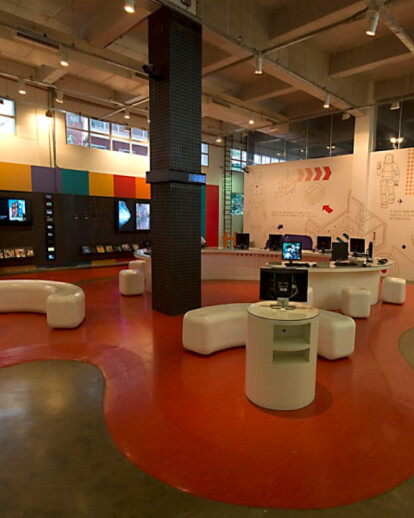The Project for the Colégio Estadual José Leite Lopes and NAVE (Núcleo Avançado em Educação) took shape in the partership between the Instituto Oi Futuro and the Rio de Janeiro State Government. The implementation of a new pedagogical outcome of this partnership aims to support high school students from the public system.
Choosing the site of the school interfered primarily in developing a project that not only would fulfill the pedagogical and functional needs of the school, but would also transcend this basic item. The site chosen by the OI Futuro Institute for this school is a block of two buildings, which currently runs the Center for Distribution of Telephone Lines OI. The major objective of the project consists in attending the school needs while isolating the technical areas of this center because it is impossible to completely relocate the former use.
However, the challenge of reconciling two seemingly inharmonious uses is interesting when we relate that question global trends promoted in the reconstruction and transformation of large cities like Rio de Janeiro, and its crowded urban centers of concrete, glass, steel and people.
The new social conditions, and therefore, architectonical, interfere in the life of cities, which have, in their heterogeneous condition, been finding outlets for curious examples of incompatible uses such as this. Where the occupations of the voids and overlapping systems of mobility have been constantly changing, being nowadays key to good balance between activities that apparently do not communicate.
In the case of our project for the NAVE Tijuca, the first step was to understand the usage of the areas which necessarily had to remain isolated from their maintenance activity and programming. Isolating these areas clarified the directions to be taken in other areas that would interfere in school activities.
The next step was to take account of the empty spaces left for the occupation of the school, creating an independent system of uses and circulation by inserting a staircase building, which connects the floors occupied by the new use, meeting the needs of accessibility and new dynamics of the place. Internally, an old staircase and three elevators also conspire to adapt to the new use.
The staircase building is made up of a steel structure, covered by a jacket of expanded galvanized plates with various gradients and shades of transparency, bringing the main facade to a new intervention result of the reform of the spaces and adapting the new use. The new stretches and exposes the city by the insertion of a technical platform, which serves as support NAVE logo and a roving panel, created by the designer Jair de Souza, who wears part of the facade of the old building with images made by students.
The access areas for the students, school officials and the public are located on the first and second floors, as the ground floor, which is located on level +1.23 m, is taken by the OI Central Communication. The first floor is at level +4.19 m and basically functions as customer service, management, staff room, dining room, kitchen, service and maintenance. This level +4.19 m is the same of the service access located in Santa Maria Rossel side street, where we can find the service control kiosk , access for loading and unloading and an area for the employees. The Second Floor, level +7.11 m is located the first floor of Laboratories, Auditorium (119 people) and Exposition Area. The 3rd. Floor, level +12.80 m, and 4th. Floor (level +18.30 m) are occupied by classrooms. On the last floor, level +24.09 m, is located the sports court and dressing rooms, which will be subjected to later removal.
The floors are configured as large empty spaces filled by volumes that carry within them their specific use, being able to identify in this emptiness the volumes that are the classrooms and other activities. This is the attitude that defined the form of construction and use of classrooms, rendering usage of the preexisting windows and air conditioning system in each floor.
With this specificity, the care for the acoustics, the functioning of the rooms and its outdoors is crucial. Therefore, to meet this need, it was developed by eng. Moyses Zindeluk in partnership with our office, a system of absorption and reflection of sound that makes the environment of virtually open classrooms, acoustically appropriate for school activities, without disqualifying the architectural concept of space occupation by the volumes and recovery mechanical systems for air conditioning systems available.
The same interventionist spirit that was shaped by the renovations and partial changes of the usage of this set of buildings, inspired the visual design adopted by Jair de Souza, who brought the stereotype of the "digital language" into the school, making the graphics applied walls, ceiling and floor a significant mark on the architecture of the spaces of the NAVE and the Escola Estadual José Leite Lopes.





























